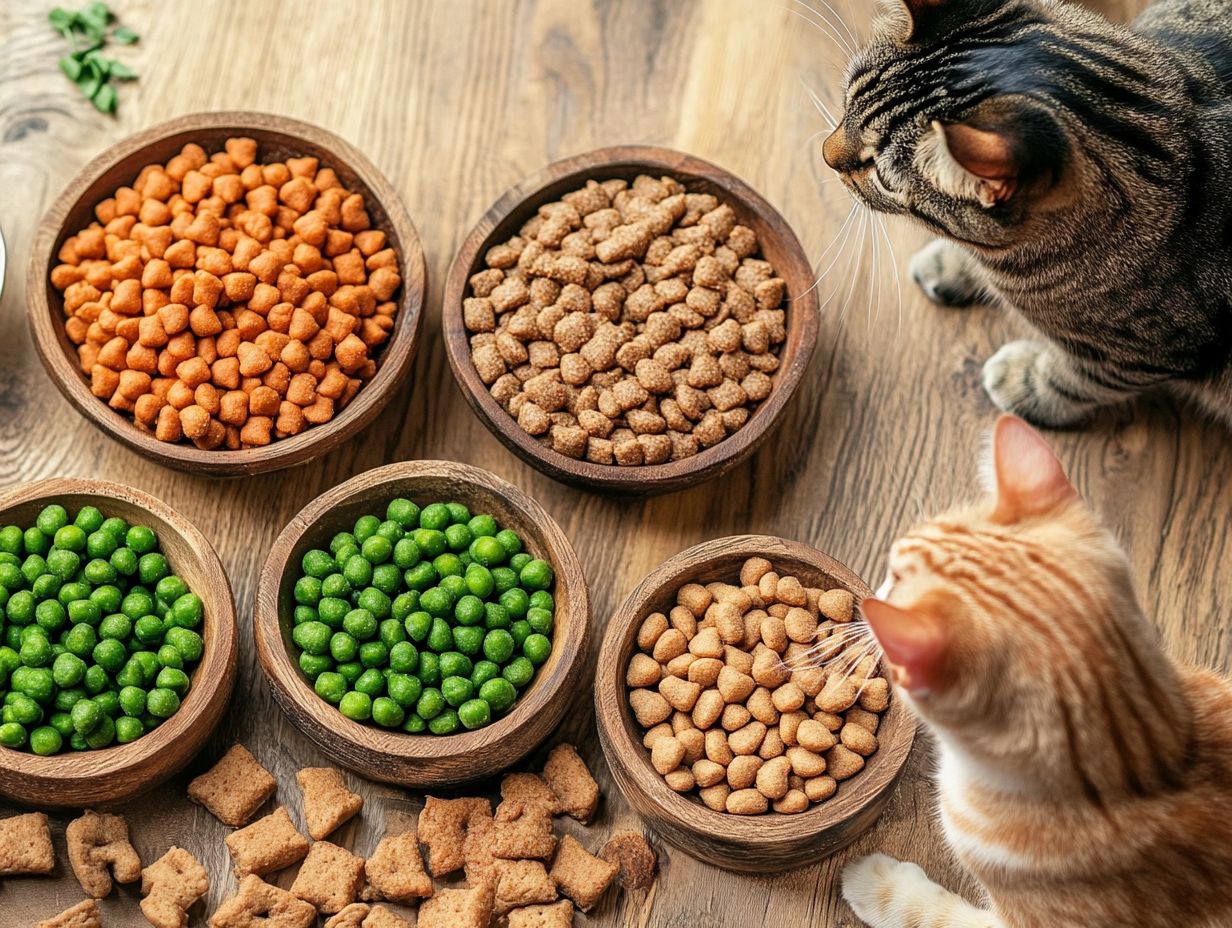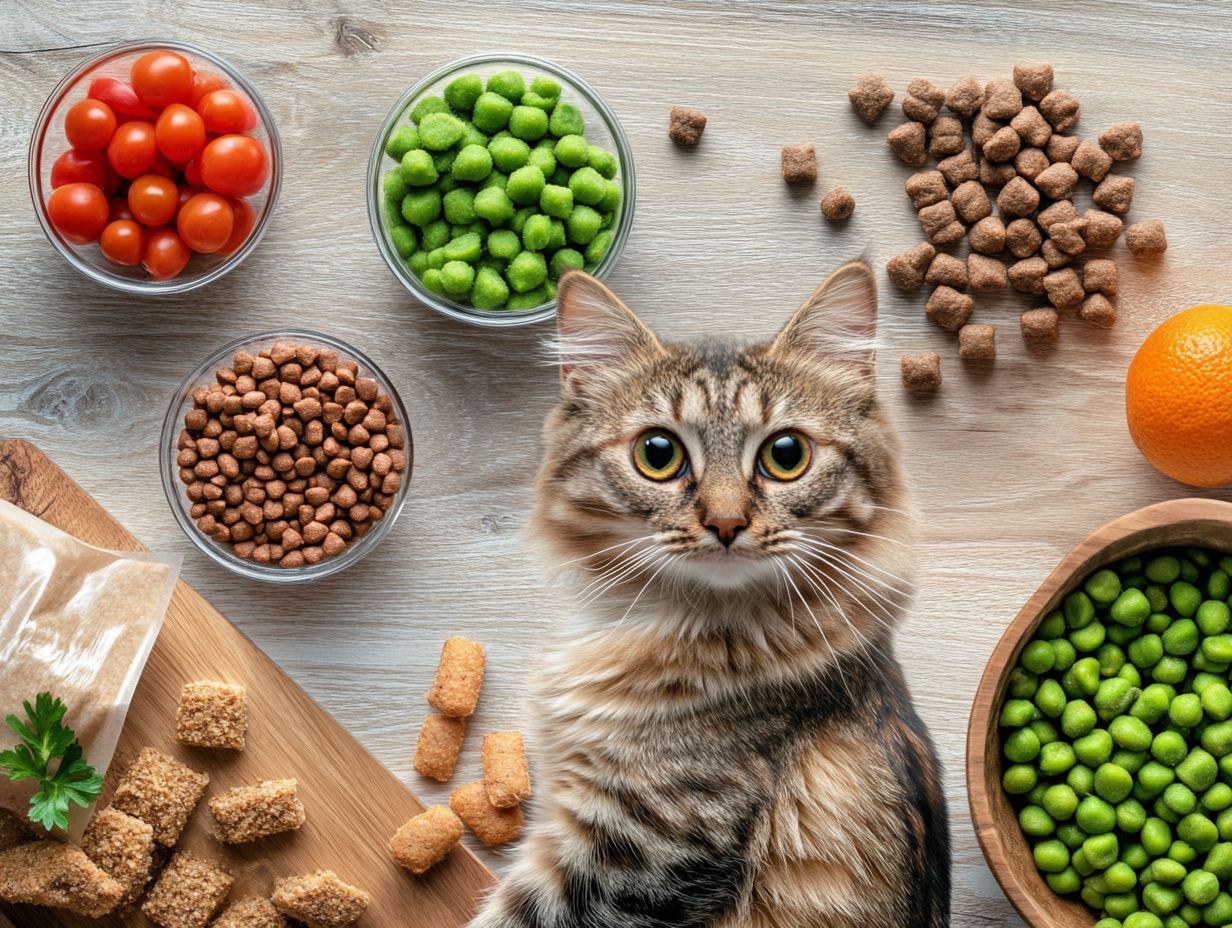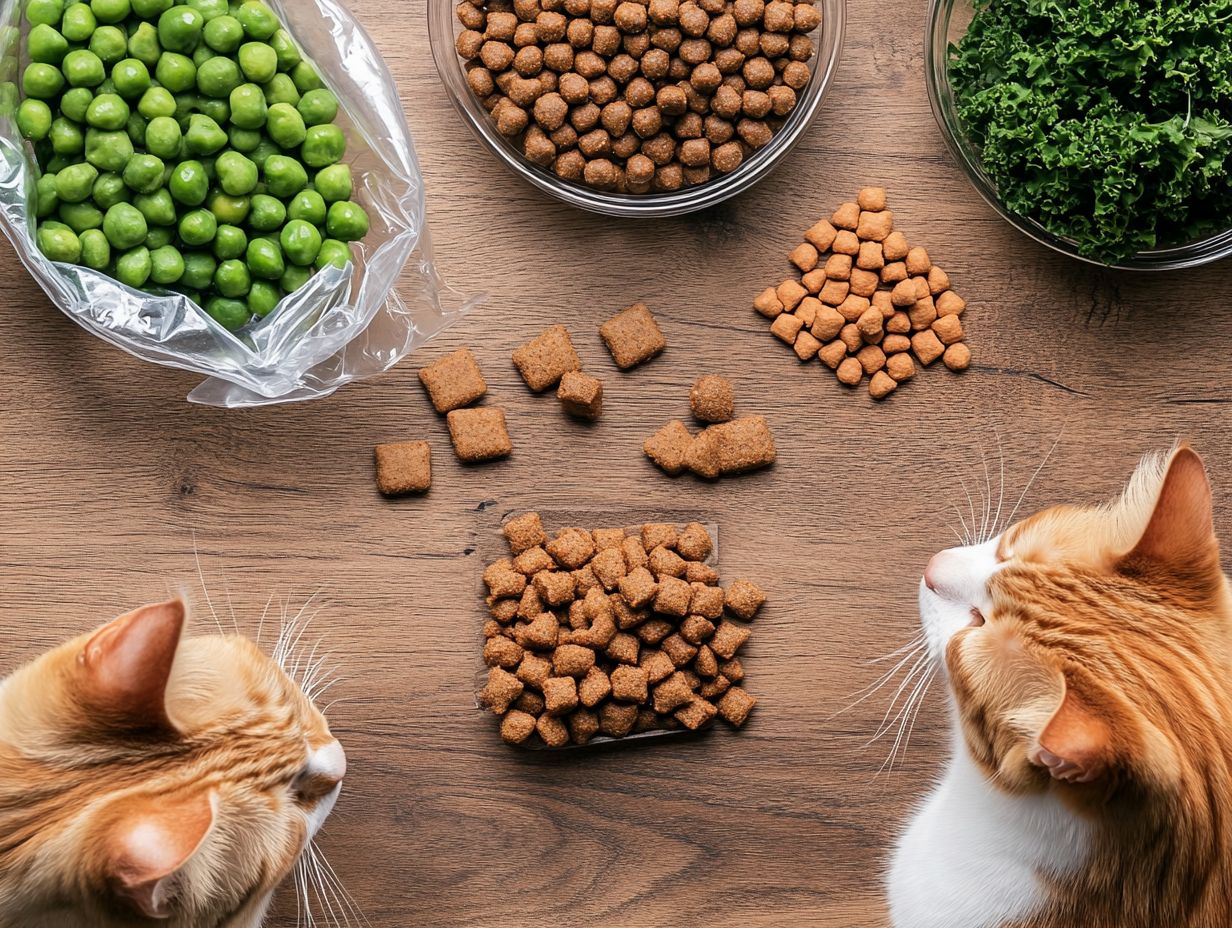Finding the right diet for your obligate carnivore can feel overwhelming, especially when addressing food sensitivities such as allergies and intolerances while prioritizing their health with high-quality animal proteins.
High-protein, low-allergen cat food, often referred to as hypoallergenic cat food, is becoming a popular choice for cat owners seeking to balance nutrition with their cat’s dietary needs and sensitivities. Before making significant dietary changes, particularly for cats with existing health issues, consulting a veterinarian is essential.
We will explore the significance of this diet, identify common allergens, and highlight the best protein sources, including animal proteins like turkey and salmon, to ensure your cat thrives.
Additionally, tips on transitioning to this specialized diet and recommendations for top cat food brands such as Royal Canin, Blue Buffalo, and Natural Balance that prioritize high-quality ingredients will be provided. Remember to monitor your cat’s weight and body condition during the transition, referring to the latest feline obesity guidelines.
Dive in to discover how to keep your cat happy and healthy with the right food choices!
Key Takeaways:

- Hypoallergenic cat food is specially formulated to balance both nutrition and sensitivity in cats by utilizing limited ingredient lists.
- It is important to prioritize this type of cat food as it can provide numerous benefits to your feline friend’s overall health.
- To ensure your cat is getting proper nutrition and avoiding potential allergens, look for specific protein and carbohydrate levels and carefully read ingredient lists on cat food brands.
What Is High-Protein, Low-Allergen Cat Food?
High-protein, low-allergen cat food is specifically designed for cats with dietary sensitivities. These formulations feature a unique blend of ingredients that promote digestive health, skin health, and overall immune support.
Typically, high-protein, low-allergen cat foods include high-quality protein sources such as turkey, chicken, duck, or salmon, which are less likely to trigger food allergies in cats. Additionally, these specialized diets often have limited ingredient lists and incorporate hydrolyzed proteins to enhance flavor while minimizing allergenic components. While high-protein, low-allergen cat foods may benefit cats with sensitivities, it’s essential to recognize that each cat’s dietary needs may vary; therefore, veterinary advice is crucial.
This approach ensures a healthier diet for cats with sensitive stomachs.
Why Is High-Protein, Low-Allergen Cat Food Important?
High-protein, low-allergen cat food is essential for cat owners seeking to support their pets’ optimal digestive and skin health, particularly when the cat suffers from food allergies or intolerances. For more information, check out this high-protein, low-allergen cat food.
Many cats develop sensitivities to common allergens such as soy, corn, and wheat, leading to chronic conditions that require specialized dietary solutions. These allergens can result in gastrointestinal upset or skin problems. Veterinary guidance and recommendations often play a crucial role in helping cat owners select specific cat food formulas to ensure the overall well-being of their feline companions.
What Are the Benefits of High-Protein, Low-Allergen Cat Food?
High-protein, low-allergen cat food offers numerous advantages that significantly enhance cats’ overall health, address dietary sensitivities, and improve their quality of life. These diets minimize allergenic ingredients while enriching essential nutrients, leading to better digestive health, increased energy levels, and improved skin condition. They are fortified with omega fatty acids and probiotics, which support immune function and enhance overall well-being.
While high-protein, low-allergen cat foods offer many benefits, it’s critical to ensure they include sufficient animal-source proteins to prevent nutritional deficiencies. The easy-to-digest proteins in these specialized diets provide relief for cats with food intolerances, alleviating common gastrointestinal issues and enabling them to enjoy a happier, more active lifestyle.
Carefully selected ingredients also contribute to weight control by ensuring that cats receive adequate nutrition without unnecessary fillers, helping to maintain a healthy weight.
Increased energy levels promote playful behavior, which is vital for emotional health. Additionally, the antioxidants and prebiotics found in these foods strengthen the immune system, allowing cats to thrive and be more resilient to illnesses, much to the relief of their owners.
What Are Common Allergens in Cat Food?
Common allergens found in cat food can negatively impact a cat’s health and are often linked to food allergies that result in gastrointestinal issues or skin irritation. The most frequent ingredients that trigger allergic reactions in cats include soy, corn, wheat, and certain animal proteins. Consult a veterinarian for a proper diagnosis and dietary plan tailored to your cat’s specific needs.
As you consider dietary changes for your cat, it’s important to conduct further research and maintain regular check-ups with your veterinarian to ensure that your cat’s dietary needs are being met as they age or if their health conditions change.
Therefore, cat owners should closely examine ingredient lists when selecting food. Identifying and eliminating common allergens can help manage chronic conditions and enhance a cat’s overall quality of life. While soy, corn, and wheat are known allergens, it’s important to note that individual cats may have unique sensitivities not reflected in general lists.
What Ingredients Should Be Avoided in Cat Food?

Certain ingredients should be avoided in cat food due to their potential to trigger food allergies and intolerances in cats. Common allergenic ingredients include soy, corn, and wheat. However, other low-allergen ingredients to be cautious with include dairy and certain artificial additives that may cause gastrointestinal upset or skin irritations.
Low-allergen cat food options, often referred to as limited-ingredient or hypoallergenic, utilize high-quality and specialized ingredients, focusing on nutritional value and single high-quality protein sources. While cats can develop allergic reactions to nearly any ingredient, cat owners can help mitigate these issues by avoiding the most common allergenic sources.
Cats that exhibit signs of allergies, such as itching, vomiting, diarrhea, or excessive grooming, may benefit from foods that prioritize ingredient sourcing and transparency. Choosing brands that clearly label their ingredients and avoid fillers and by-products ensures that cats receive the best diet tailored to their individual needs. Consulting with a veterinarian before switching to any specialized diet, particularly for cats with existing health conditions, is crucial.
This approach not only helps minimize potential allergic reactions but also provides proper nutrition, which is essential for enhancing their overall health and lifespan.
How to Determine if Your Cat Has Food Sensitivities and Allergic Reactions?
To determine if your cat has food sensitivities, closely observe their behavior after eating certain foods. Food allergies in cats can manifest in various symptoms, particularly digestive issues or skin irritations. It’s essential to follow your veterinarian’s advice for knowing what signs to look for and how to develop a plan for a healthier diet that suits their needs, especially when considering a gradual introduction of new foods over a period of 7-10 days to prevent gastrointestinal upset.
Monitoring your cat’s overall health and any chronic conditions can greatly assist in identifying problematic food ingredients. Additionally, it’s important to understand the AAFCO nutrient profiles to ensure that all commercial cat foods meet minimum nutritional standards, focusing on the relevance of protein content in these profiles.
What Are the Best Protein Sources for Cats?
High-quality protein sources are essential for meeting cats’ dietary needs and promoting their overall well-being, especially for those with food allergies or sensitivities. Animal proteins such as turkey, chicken, duck, and salmon are often recommended, as they provide all the essential amino acids while having a lower likelihood of causing allergic reactions.
Hypoallergenic cat food options typically emphasize single protein sources, allowing cat owners to easily monitor the quantity of each protein they provide and adhere to their veterinarian’s guidance.
What Are the Recommended Protein Levels for Cats?
The recommended protein levels for cats vary based on their age, health status, and dietary sensitivities, but they should generally be high to support optimal health and energy. Adult cats typically require around 30-40% protein in their diet, while kittens may need even higher levels to promote growth and development.
Consulting with a veterinarian can provide tailored recommendations based on individual health needs, ensuring that cat owners select high-protein food formulations and trusted brands like Hill’s Prescription Diet that meet these nutritional requirements. Factors such as activity level also play a crucial role in determining a cat’s protein needs; for example, an active cat may burn more calories and require higher protein levels than a more sedentary one.
Additionally, certain health conditions, like kidney disease or diabetes, may necessitate adjustments in protein intake, complicating dietary choices further. When examining cat food labels, it is essential to look for quality protein sources and to pay attention to the percentage of protein listed, ensuring it aligns with the veterinarian’s guidance. It’s also beneficial to incorporate omega-3 and omega-6 fatty acids for skin and coat health, especially for cats with allergies.
This careful approach not only supports their physical well-being but also fosters a thriving lifestyle through proper pet nutrition and ingredient transparency. Proper food storage and handling practices, such as refrigerating opened raw food and discarding any food past its expiration date, are essential to avoid spoilage.
What Are the Best Low-Allergen Ingredients for Cats?
Hypoallergenic cat food is made using the best low-allergen ingredients to minimize the likelihood of allergic reactions and support optimal health for cats. Commonly used less allergenic ingredients include lamb, rabbit, and certain types of fish. It is crucial to consult with a veterinarian before considering homemade diets or raw feeding, as these can come with potential risks of nutritional deficiencies.
Veterinary consensus emphasizes the importance of maintaining a balanced diet throughout different life stages (kittens, adults, seniors) to ensure all nutritional needs are met at each phase.
Additionally, specialized ingredients like hydrolyzed protein and probiotics are a valuable addition to cat food, as they promote healthy digestion and support skin health. Veterinarians recommend consulting on appropriate dosages, as these components can enhance overall well-being while avoiding fillers and common allergens like soy and corn. For more authoritative information, check out this article on Nutrition for Cats from the American Veterinary Medical Association.
How to Transition Your Cat to a High-Protein, Low-Allergen Diet?
Transitioning your cat to a high-protein, low-allergen diet should be done carefully and gradually over a period of time. This approach allows your cat to adjust to the new food and helps prevent digestive upsets and manage dietary sensitivities. Signs of successful adaptation include improved coat condition and increased energy levels, while adverse reactions may include vomiting or diarrhea. Monitor your cat closely for any signs of food intolerance or food allergies, such as changes in stool or other gastrointestinal issues.
Begin by introducing a small amount of the new food into your cat’s regular diet, gradually increasing the proportion of new to old food over the course of 7 to 10 days. Your veterinarian can recommend the best cat food that meets your animal’s nutritional needs during this transition.
What Are the Recommended Carbohydrate Levels for Cats?
The recommended carbohydrate levels for cats are low, typically around 5-10% of their diets, as cats are obligate carnivores that evolved to rely on animal-based proteins for energy. Their digestive systems are not designed to handle high carbohydrate diets, which can lead to issues such as obesity and other health problems, particularly in cats with dietary sensitivities.
It is essential to choose high-quality, low-carbohydrate ingredients in cat food formulations to ensure proper nutrition without compromising health, focusing on unique recipes that address dietary sensitivities.
Carbohydrate levels are crucial because many commercial cat foods may contain hidden sugars and fillers. An excessive amount of carbohydrates can disrupt a cat’s metabolism, potentially leading to diabetes or liver disease and other chronic conditions over time. Therefore, food labels should emphasize protein sources and low carbohydrate content, while avoiding those high in by-products, artificial additives, or common allergens like soy, corn, and wheat.
Ingredients such as meat meals, fish, and organ meats should be prioritized, along with limited ingredient options like duck, venison, and rabbit, to create a nutrient-rich diet that enhances immune support and helps cats thrive and enjoy a long, healthy life.
What Are Some High-Protein, Low-Allergen Cat Food Brands?
Here are some of the best high-protein, low-allergen cat food brands that adhere to AAFCO standards:
- Royal Canin
- Blue Buffalo
- Hill’s Prescription Diet
- Natural Balance
- Evanger’s
- Purina Pro Plan
These trusted brands are recognized for their high-quality ingredients and carefully formulated recipes that promote digestive health and high palatability while minimizing allergy-causing components.
What Are the Key Ingredients to Look for in These Brands?
The key ingredients in high-protein, low-allergen cat food brands are crucial for meeting your pet’s health needs while ensuring ingredient transparency and protein sources. A close examination of the label reveals important information about the nutrient sources and overall quality.
Formulations that feature high-quality animal proteins, such as turkey, chicken, or fish, are essential, as they support muscle development and overall vitality. Omega fatty acids and probiotics further enhance health. Omega fatty acids contribute to maintaining healthy skin and a shiny coat. Always read labels carefully to avoid common allergens and ensure the presence of quality animal protein, adhering to AAFCO labeling guidelines.
How to Ensure Your Cat Is Getting Proper Nutrition on a High-Protein, Low-Allergen Diet?
Ensuring proper nutrition for a high-protein, low-allergen diet for cats involves selecting appropriate cat food that meets their nutritional needs in line with veterinary recommendations. The ingredients should be high-quality and sourced transparently, emphasizing high protein content while excluding common allergens.
It’s also important to discuss raw or homemade diets with a veterinarian, outlining both potential benefits and risks related to these diets, including nutritional completeness and safety.
Furthermore, proper food storage and handling practices are vital. Ensure that both wet and dry cat food are stored in a cool, dry place and check for spoilage. Signs of spoilage may include off smells, discoloration, or mold.
Regular health assessments of the cat and consultations with veterinarians can help ensure proper nutrition and address food intolerances and allow for adjustments to dietary needs when necessary.
What Are the Potential Side Effects of Switching to a High-Protein, Low-Allergen Diet?

Transitioning your cat to a high-protein, low-allergen diet may lead to occasional health issues, some potential side effects, particularly during the adjustment period as their digestive system adjusts to the new ingredients.
Common side effects can include mild gastrointestinal upset, such as diarrhea or vomiting, especially if the transition is not carried out gradually. Seeking guidance from a veterinarian can help minimize these effects and ensure that the new diet is suitable for your cat’s sensitive digestive systems and health.
This video explains the benefits and potential side effects of high-protein, low-allergen diets for cats.
Frequently Asked Questions
What is High-Protein, Low-Allergen Cat Food?
High-Protein, Low-Allergen Cat Food is a type of cat food that is formulated with a high amount of animal-source protein and minimal allergens, making it ideal for cats with food sensitivities.
Why is it important to balance nutrition and sensitivity in cat food?
Cats with food sensitivities often require specific diets to manage food sensitivities effectively. However, it’s also important to ensure that the diet is nutritionally balanced to support your cat’s overall health and well-being.
What are the benefits of feeding your cat High-Protein, Low-Allergen Cat Food?
High-Protein, Low-Allergen Cat Food offers a range of benefits for your cat, including improved digestion, healthier skin and coat, and increased energy levels. While it may improve digestion and coat health, some cats may not react positively to high-protein diets. It also helps to reduce the risk of developing food allergies or intolerances.
Is High-Protein, Low-Allergen Cat Food suitable for all cats?
While High-Protein, Low-Allergen Cat Food can be beneficial for many cats, it’s always best to consult with your veterinarian for veterinary guidance before making any changes to your cat’s diet. They can help determine if this type of food is suitable for your cat based on their individual needs and health conditions.
What ingredients should I look for in High-Protein, Low-Allergen Cat Food?
When selecting a High-Protein, Low-Allergen Cat Food, look for high-quality animal protein as the first ingredient listed, such as chicken, turkey, or fish, and avoid common allergens such as grains, dairy, and soy. It’s also important to check the ingredient list for any fillers and by-products that could be harmful to your cat.
Are there any potential drawbacks to feeding my cat High-Protein, Low-Allergen Cat Food?
While High-Protein, Low-Allergen Cat Food can offer numerous benefits, it’s important to note that it may not be suitable for every cat. Some cats may have specific dietary needs or medical conditions that require a different type of food. Always monitor your cat’s health continuously and consult with your veterinarian before making any changes to your cat’s diet to avoid potential nutritional deficiencies.